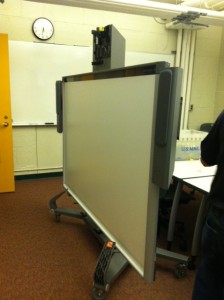 There is simply too much going on. There have been several days of back to back meetings, some exciting software development and some minor crisis management and course corrections to a major project – the usual stuff that a CIO has to deal with. Talking about course correction, we had installed a SMART board in one of our classrooms (we planned four this semester) which was interfering with the use of the chalk board. This was not caught earlier because of some minor communications issues. We needed to do something quick, so we scrambled to move it to a mobile stand. One of our staff found a stand available in eBay, bid and won the bid. Of course, not many all over the world are waiting in line for a Mobile stand for a SMART Board, but still, it was fun. As a backup we also ordered the “real thing”, which apparently is manufactured or assembled only on demand. In the end, the eBay version had some missing parts and could not be used and the “real thing” came, but scheduling human resources to put it together took time, but finally it is done. The board itself weighs about 500 pounds and the stand another 200. I am being told that it was manageable to move short distances. The board’s movement up and down is done with a switch. Though this has been delayed, the faculty who were planning on using it have been very understanding, so all is well.
There is simply too much going on. There have been several days of back to back meetings, some exciting software development and some minor crisis management and course corrections to a major project – the usual stuff that a CIO has to deal with. Talking about course correction, we had installed a SMART board in one of our classrooms (we planned four this semester) which was interfering with the use of the chalk board. This was not caught earlier because of some minor communications issues. We needed to do something quick, so we scrambled to move it to a mobile stand. One of our staff found a stand available in eBay, bid and won the bid. Of course, not many all over the world are waiting in line for a Mobile stand for a SMART Board, but still, it was fun. As a backup we also ordered the “real thing”, which apparently is manufactured or assembled only on demand. In the end, the eBay version had some missing parts and could not be used and the “real thing” came, but scheduling human resources to put it together took time, but finally it is done. The board itself weighs about 500 pounds and the stand another 200. I am being told that it was manageable to move short distances. The board’s movement up and down is done with a switch. Though this has been delayed, the faculty who were planning on using it have been very understanding, so all is well.
Professor Jay Turner from Environmental Studies asked if I would like to join a reading group of students and faculty (Jay, Kristina Jones and Alden Griffith) discussing Technology and Environmental Sustainability this semester. This week’s topic of life-cycle of digital electronics and solar panels was interesting, so I decided to go. I took some time to read through the assigned readings – Paper vs Digital, Solar Panels, and Chapter 2 from the book “High Tech Trash: Digital Devices, Hidden Toxics, and Human Health” by Elizabeth Grossman. They are all excellent reads and I especially recommend the last one. I think many of us who are technologists have no clue about what is the real environmental cost of making digital devices. We all know that it is pretty high, but I doubt very much that anyone knows that mining for 1 ton of copper results in 310 tons of waste in terms of rocks and ore. This is huge. But like everything else, there is a lot more to it. For example, base metals like copper are also easily recyclable – whether they get recycled at a rate that is high and desirable is a whole another question. What follows is a short collection of a wide ranging set of topics discussed during the class without particular attribution to who said what.
Disclaimer: It is highly possible that my interpretations of a few things discussed may not be accurate, so feel free to comment on them or send me the corrections!